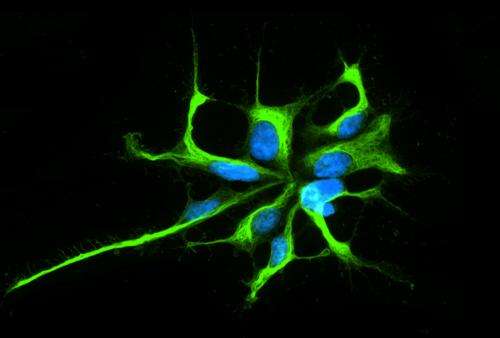Rapid toxicity test for household, industrial compounds

Multiyear testing methods have left the U.S. Environmental Protection Agency with a list of 80,000 household and industrial compounds that need to be assessed to determine potential health risks.
The average American comes in contact with thousands of these chemicals each year. The biggest concern, though, is determining which of these compounds disrupt early fetal and infant brain development.
To help change the paradigm of how these chemicals are tested—and how rapidly the EPA receives results—the agency tapped researchers in the University of Georgia Regenerative Bioscience Center. The university is one of three institutions sharing a $3 million grant from the EPA to more quickly determine the physiological effects of environment chemicals on children and infants.
Until now, determining the toxicity of each chemical could take almost two years. The UGA Regenerative Bioscience Center's $799,938 share of the grant will allow researchers to modernize the current testing process using work they pioneered using undifferentiated cells.
"We hope to do a study in a dish that can be completed within a week so we'll be able to speed up the process and make it less expensive and not have to use animals," said center Director Steve Stice, a Georgia Research Alliance Eminent Scholar in Reproductive Physiology in the UGA College of Agricultural and Environmental Sciences.
Because of the damaging presence of these toxicants, early interruptions in brain development can lead to a broad range of lifelong problems. With one in six children in the U.S. diagnosed with a developmental or cognitive disorder, "it is more important than ever to understand the potential toxicity in the chemicals that we come in contact with every day," Stice said.
The methods used by the Regenerative Bioscience Center will expand the number of chemicals that can be tested each year, reducing process time, effort and cost while also minimizing animal use.
"This is an opportunity to further foster interdisciplinary research that encompasses toxicology, neural development, stem cells and new imaging technology," Stice said.
"This grant will span a wide range of disciplines to follow a toxin's initial effects at the neural stem cells to how it affects people, potentially leading to uncovering environmental causes of autism. With EPA funding we can be a task force of a much needed solution."
Stice presented the topic, "Human Neural Stem Cell Metabolomic, Cellular and Organ Level Adverse Outcome Pathway Relationships for Endocrine Active Compounds," to 6,000-plus toxicologists from more than 50 countries on March 25 at the EPA Grants Kick-Off Meeting, part of the annual Society of Toxicology gathering in Phoenix, Ariz.
"By better predicting whether chemicals have the potential to impact health and human development, these grants will not only advance the science necessary to improve chemical safety but protect the well-being and futures of children in this nation," said Lek Kadeli of the EPA's Office of Research and Development.
















